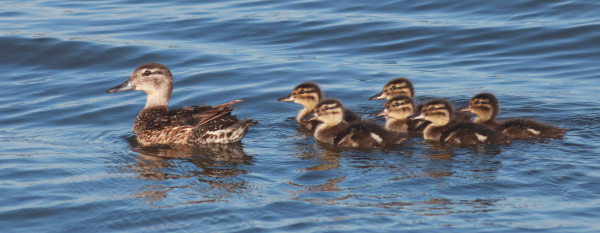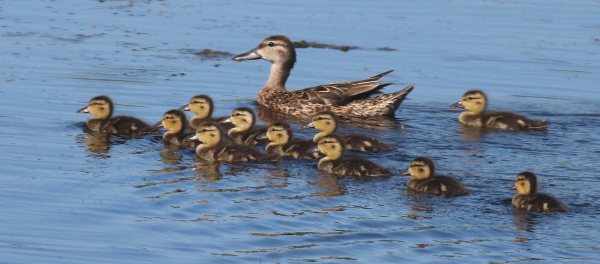A couple weeks ago, I checked out a favorite corner of a shallow marsh; and although I didn’t see any promising photo ops, as I slowly moved forward, a couple tiny ducklings popped out of the shoreline cover closest to me, followed by a female teal and more downy duckies. They quickly moved into formation with the hen leading the way with her brood in tow, so to speak.
Of course, I quickly began photographing the attractive new brood, and I took a series of photos as they slowly, but deliberately swam a short distance away. My initial reaction was: Another fine Blue-winged Teal brood provided a fulfilling birding experience and a nice photo series from which I can glean a nice image or two. I probably have more photos of Blue-winged Teal broods than any other ducks, so I was a bit reserved about the surprise encounter. I continued on my way and enjoyed a nice field trip with many other enjoyable sightings mixed with a couple nest site updates and more photo ops.

A few hours later, when I reviewed my digital photos in my laptop computer, I selected the first photo featured in this article to crop the surrounding water a bit, name and date it, and file it. I named it “Ducks - Blue-winged Teal brood 8-19” plus a couple filing notes. Thinking there might be a second image I could edit from the teal brood series, I took a second look at them and, to my surprise, I noticed a portion of telltale iridescent green speculum feathers on the female’s wing – it was a Green-winged Teal, making this the first Green-wing brood I’ve seen in the area for a couple years – and my first good photos of a newly hatched Green-winged Teal brood! Whoo-woo!
So I really didn’t question my ID “miss” too much, it was innocent enough – I was caught up in the excitement of the moment – the photo opportunity before me – and I may have been a bit complacent, considering that every other teal brood I had seen this season and last year was a Blue-wing. Plus, whether you’re viewing birds through an 8x binocular, a 15x spotting scope or a 400mm camera lens, there’s a fine line where we might make a mistake identifying a given species, even one we’re familiar with.
I almost always identify duck broods by identifying the hen, but we all know female ducks only offer subtle differences. Even so, after seeing and identifying a minimum of tens of thousands of female ducks, I almost never have a problem identifying female ducks. If you see ducklings without a female, that’s a different story. I’m quite familiar with the 14 species of ducklings I might encounter here in the northern plains, but I wanted to check the differences in the look of newly hatched ducklings – were Green-wings very different from Blue-wings? So I went upstairs to my library to check my waterfowl references, and found that the artwork used to illustrate teal ducklings, showed what appeared to be a couple very subtle differences.
Next, I looked back at some recent Blue-winged Teal brood photos I’ve taken this summer and last year, and found that while the single reference book illustrations of each duckling species were accurate, there was more variability in the markings and coloration of ducklings in the field, even among ducklings in the same brood. However, the Green-wing ducklings have a telltale second linear mark underneath the eye stripe, plus they are a bit darker, although that can be variable depending on the light. Blue-wings also appear to have more of a yellow hue in the lighter portions of their down.
Refer to the second photo in this article, which shows a female Blue-wing with her similarly week-old brood, so you too can compare the ducklings and the females. Actually, different hues of light probably depict the birds more differently than anything else, and even the water color and the amount of movement on the water makes a difference in visual perceptions of the ducks.

So having written that, the Green-wing female is a bit more compact with a little different head shape and shorter neck overall, and probably slightly darker colored, but that’s a lot easier to judge in an enlarged photo than while photographing a moving subject in the field and not really paying attention to identification details at the time.
Anyway, we don’t get many Green-winged Teal in south-central North Dakota, but Blue-winged Teal are usually one of the four most common nesting birds, and given past history when I’ve encountered very very few Green-winged Teal broods, it was a quickly made, honest mistake, which I was able to catch through the use of photos – an important aspect of birding, and even bird biology.
Overall, a camera fitted with a 400mm (10x) telephoto lens can be the most important equipment for birders in the field, because you can look through the camera lens to get a magnified view of any bird – plus you can take a photo or two to Document the bird, so you can take an even closer look by enlarging the image and get a still (inactive) look for identifying characteristics. Certainly, getting a documentary photo of a rare bird is the bottom line for verifying any rare bird sightings, and a photo can be used to verify any birds you have questions about in the field. Reviewing your photos becomes part of the birding experience too.
Yes, the camera and lens combo you use for bird photography may be the most important birding equipment in the field – not to mention that photographing birds may be the most fulfilling aspect of birding.
Addendum: Luckily, Cinnamon Teal don’t nest this far east, because the females are pretty identical to Blue-winged Teal hens without an attendant drake next to them. As for Cinnamon Teal ducklings, they appear to be pretty identical to Blue-wings too – my favorite reference book shows no discernable differences; but that’s another can ‘o worms, or another box ‘o ducklings.
Article and photographs by Paul Konrad
Share your bird photographs and birding experiences at editorstbw2@gmail.com
